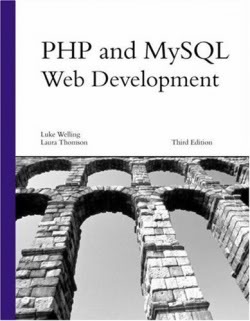PHP and MySQL Web Development


Author: Luke Welling and Laura Thomson
Paperback: 912 pages
Publisher: Sams; 2 edition (February 12, 2003)
Language: English
ISBN-10: 067232525X
ISBN-13: 978-0672325250
Source Files: yes
Format: pdf
Details:
Learning PHP is worth your time because you can do so much with it. Backed by a MySQL database server, the language makes an extraordinary engine for doing server-side scripting on Web sites. PHP and MySQL Web Development aims to unravel the wonderful possibilities of the two title technologies by walking the reader through tutorials, then presenting a series of moderately elaborate example projects. The PHP tutorial will impress anyone coming to the language from simple HTML work, and the MySQL tutorial is adequate for most applications (though it ignores the relational capabilities that appeared in version 4 with the InnoDB table type). If you like to study code (both listings and commentary), you'll appreciate the authors' solutions to common problems, like implementing shopping sites and managing restricted-access rules.
The programming approach of Luke Welling and Laura Thomson is procedural, neglecting the object-oriented capabilities of PHP almost entirely. It's a valid choice, as most PHP code is written in procedural style. As well, they've chosen to build their software around PHP 4.3, which doesn't have as much object-orientation capability of the new version 5 release. Some readers may lament the lack of up-to-date coverage, but others--perhaps serving sites from hosting services that run well-proven PHP 4.x--will appreciate that the authors took time to revise their PHP 4.3 code samples (which should, in most cases, be backward-compatible), rather than writing PHP 5 code for its own sake. --David Wall
Topics covered: How to program with PHP 4.3 (and its predecessors) and store data in a MySQL database. PHP coverage is extensive, covering all capabilities from basic form-handing to Web Services, while MySQL coverage is limited to the essentials of database setup and administration. Elaborate applications--such as a PDF generator and a content-management system--are written in a way that invites learning and adaptation.

Code: Select All


Author: Luke Welling and Laura Thomson
Paperback: 912 pages
Publisher: Sams; 2 edition (February 12, 2003)
Language: English
ISBN-10: 067232525X
ISBN-13: 978-0672325250
Source Files: yes
Format: pdf
Details:
Learning PHP is worth your time because you can do so much with it. Backed by a MySQL database server, the language makes an extraordinary engine for doing server-side scripting on Web sites. PHP and MySQL Web Development aims to unravel the wonderful possibilities of the two title technologies by walking the reader through tutorials, then presenting a series of moderately elaborate example projects. The PHP tutorial will impress anyone coming to the language from simple HTML work, and the MySQL tutorial is adequate for most applications (though it ignores the relational capabilities that appeared in version 4 with the InnoDB table type). If you like to study code (both listings and commentary), you'll appreciate the authors' solutions to common problems, like implementing shopping sites and managing restricted-access rules.
The programming approach of Luke Welling and Laura Thomson is procedural, neglecting the object-oriented capabilities of PHP almost entirely. It's a valid choice, as most PHP code is written in procedural style. As well, they've chosen to build their software around PHP 4.3, which doesn't have as much object-orientation capability of the new version 5 release. Some readers may lament the lack of up-to-date coverage, but others--perhaps serving sites from hosting services that run well-proven PHP 4.x--will appreciate that the authors took time to revise their PHP 4.3 code samples (which should, in most cases, be backward-compatible), rather than writing PHP 5 code for its own sake. --David Wall
Topics covered: How to program with PHP 4.3 (and its predecessors) and store data in a MySQL database. PHP coverage is extensive, covering all capabilities from basic form-handing to Web Services, while MySQL coverage is limited to the essentials of database setup and administration. Elaborate applications--such as a PDF generator and a content-management system--are written in a way that invites learning and adaptation.

Code: Select All

Comment